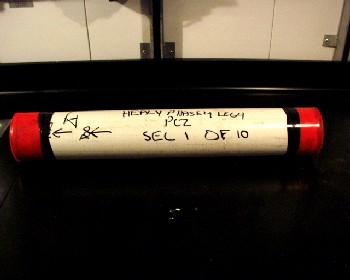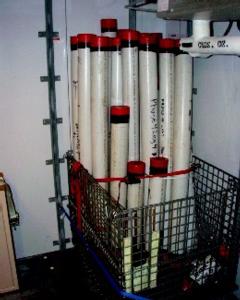23 June, 2000
A Window to the Past: Core Samples
A couple of days ago we successfully launched the corer. We were able to
bring on board a core that was just over thirty feet in length. The core
itself was not as long as what we had expected or wanted. There could be
many explanations of why the core sample was short. Two possible
explanations include: the mechanism of the corer did not worked properly and
the winch operation could have had an effect.
The core that was extruded will not be examined during this cruise. It
will be refrigerated for the trip to the Healy's homeport of Seattle. On a
normal science cruise, additional steps would be taken to prepare a sample
for research. With the aid of Garry Brass of the United States Arctic
Research Commission, I have outlined a broad summary of what might happen to
these core samples after they have been collected.
First, the core liners are split lengthwise. A nylon fishing line then
splits the core sample itself into two "D" shaped halves. Both halves are
then wrapped in plastic kitchen wrap. One half of the core sample will be
archived in a core repository, therefore it is placed in a D tube and
capped. The other half of the core sample is called the working half. It
will remain in the lab for additional work.
Most core samples are collected by a scientist, for a specific research
need. But, since these samples are archived, other scientist can use the
samples to complete their own research. One extraordinary discovery that
was made because an archived core sample was available to other scientists
was the evidence of the geologic time boundary between the Cretaceous and
Tertiary periods. This boundary marked the extinction of the dinosaurs and
the emergence of the mammals, which most scientists now suspect was caused
by a huge meteorite impact off the Yucatan Peninsula.
The working half will first have a glass slide scraped along the flat side
(cut surface) of the core sample. The purpose of this is to eliminate any
smears or deformities to the cores "surface" that occurred when the core was
split by the fishing line. After the scraping is completed, a description
of the core is recorded.
The core describer records the internal structure of the sample; the
depths of layers are measured and the colors of sediments are compared with
a Munson color chart. The sediment type is also noted, whether it is
composed of clay, silt, sand, or ooze.
To identify all of the visible grains in the sediment, a smear slide is
taken. Then the scraping of the core is placed on a microscope. This
process can be done in two ways, by simply adding a drop of distilled water
to the scraping and smearing it out evenly over the slide, or by adding a
plastic resin to the sample, which will spread it evenly over the slide.
After the smear is set, the describer can then identify things such as
mineral grains, plankton shells, plant matter, fish scales or teeth, and
fecal pellets that may be contained within the core sample.
More detailed investigations can continue on board or at a research
facility. These investigations may include testing of the physical
properties of the core. The shear strength of the material can be
determined using a probe. The probe determines the amount of force needed
to move the material. How quickly sound travels through the sample and what
magnetic properties is has can also be analyzed. Also, a pore analysis can
lead to information on the chemical processes of the sediment.
Once all of the descriptions and direct measurements have been completed,
the core then can be sampled. Samples of the core may be examined for the
sediment and mineral composition. A type of fossil record can also be
completed using the cores, by looking at what marine organisms have been
preserved and where they are located in relation to one another. This
information is useful in dating layers in the core samples. The dating
record for single-celled fossils is very accurate and can date samples back
as far as 60 million years ago. This information can then in turn be used
to date events such as volcanic eruptions and the help determine the rates
at which sediments are deposited.
Some very technical and complicated measurements can be completed to
determine very specific information about the climate in which the samples
were deposited. By comparing the ratio of oxygen isotopes 16O and 18O in
calcium carbonate shells of foramimfera, the temperature in which organisms
grew can be determined. This can help scientists map out climate changes
over the past 150,000 years, for samples collected in Greenland or
Antarctica. Samples of carbonates can help determine climatic conditions as
far back as 100,000,000 years ago.
Core samples are important to scientist because they provide a window to
the past. An almost continuous record of the past has accumulated on the
ocean floors. Recorded in the sediment is the some of the history of the
Earth's climate, geology and biology.

A core section ready to be split.

The core sections have been properly capped, taped, labeled, refrigerated and secured for the trip to Seattle, Washington.
Contact the TEA in the field at
.
If you cannot connect through your browser, copy the
TEA's e-mail address in the "To:" line of
your favorite e-mail package.
|
